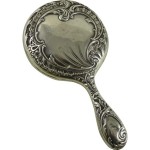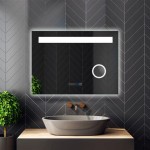Wall Mirror Metal Clips: A Comprehensive Guide
Wall mirror metal clips provide a secure and stylish way to hang mirrors of varying sizes and weights. These clips offer an alternative to traditional hanging methods, such as D-rings and wire, and can contribute to a cleaner, more modern aesthetic. Understanding the different types, materials, and installation processes is crucial for selecting the appropriate clips for a specific mirror and wall type.
Key Considerations When Choosing Wall Mirror Metal Clips
Several factors influence the selection of appropriate wall mirror metal clips. Considering these points beforehand can ensure a successful and secure installation.
- Mirror Weight and Size: Heavier and larger mirrors require more robust clips with a higher weight capacity.
- Wall Type: Different wall types, such as drywall, plaster, or concrete, necessitate specific clip types and anchors.
- Clip Style and Finish: Clips are available in various styles and finishes to complement the mirror and surrounding décor.
- Desired Look: Some clips offer a minimalist, concealed look, while others contribute to the overall design.
Types of Wall Mirror Metal Clips
A variety of wall mirror metal clips are available, each designed for specific applications and aesthetic preferences.
- J-Clips: These clips have a J-shaped design, with one end securing the mirror and the other attaching to the wall. They are commonly used for heavier mirrors and offer good support.
- L-Clips: L-clips are similar to J-clips but have a 90-degree angle, providing a more flush mounting against the wall.
- Z-Clips: These clips interlock, with one part attaching to the mirror and the other to the wall, creating a hidden mounting system. They are often preferred for a cleaner look.
- Spring Clips: Spring clips grip the edges of the mirror and are typically used for lighter mirrors or for securing a mirror within a frame.
- Decorative Clips: Some clips are designed with decorative elements, adding an ornamental touch to the installation.
Materials and Finishes
Wall mirror clips are manufactured from various materials, each offering different levels of durability and corrosion resistance.
- Steel: Steel clips are strong and durable, making them suitable for heavy mirrors. They are often finished with a protective coating to prevent rust.
- Stainless Steel: Offering superior corrosion resistance, stainless steel clips are ideal for humid environments, such as bathrooms.
- Brass: Brass clips provide a decorative touch and can develop a patina over time. They are suitable for lighter mirrors.
- Aluminum: Lightweight and corrosion-resistant, aluminum clips are a cost-effective option for lighter mirrors.
Common finishes include chrome, nickel, brushed finishes, and various painted options to match existing hardware or décor.
Installation Process
Proper installation is critical for ensuring the safety and security of the mounted mirror. While specific installation procedures may vary based on the clip type and wall material, some general steps apply.
- Measure and Mark: Carefully measure and mark the desired location of the clips on both the mirror and the wall.
- Pre-Drill Holes: Pre-drilling pilot holes is essential, particularly for harder wall materials, to prevent cracking and ensure a secure hold for the screws.
- Install Wall Anchors (if needed): For drywall or plaster walls, appropriate wall anchors are crucial for supporting the weight of the mirror.
- Attach Clips to the Mirror: Securely attach the clips to the back of the mirror using the appropriate screws.
- Attach Clips to the Wall: Align the mirror clips with the marked locations on the wall and secure them using screws and anchors if necessary.
- Hang the Mirror: Carefully hang the mirror onto the wall-mounted clips, ensuring it is securely seated.
Safety Precautions
Safety should be a primary concern when installing wall mirrors. Taking the following precautions can help prevent accidents and ensure a secure installation.
- Use Appropriate Weight Capacity Clips: Always select clips with a weight capacity exceeding the weight of the mirror.
- Use the Correct Anchors: Choose appropriate wall anchors for the specific wall type and mirror weight.
- Wear Safety Glasses: Protect eyes from dust and debris during drilling.
- Use a Level: Ensure the mirror is level during installation for a professional finish.
- Inspect Clips Regularly: Periodically check the clips for any signs of wear or loosening and tighten or replace as needed.
Choosing the Right Screws and Anchors
Selecting the appropriate screws and anchors is critical for a secure installation. The choice depends on the wall type and the weight of the mirror.
- Drywall: Drywall anchors, such as toggle bolts or molly bolts, are necessary to provide a secure hold in hollow walls.
- Plaster: Plaster walls may require specialized anchors or longer screws to reach solid framing.
- Concrete: Concrete walls require concrete screws or anchors designed for masonry.
- Screw Length: Choose screws long enough to penetrate the wall and anchor securely, but not so long that they protrude through the other side.

Black Metal Material Spring Loaded Mirror Hanger Clip Easy Temu

Clips Mirrors Mirror Accessories At Com

How To Frame A Mirror With Clips In 5 Easy Steps

Mirror Clips 4pcs Round Bathroom Supports Wall Mounted Metal Brackets Glass Hanging Holder Kit For 4 6mm Thick Frameless Com

Unframed Bathroom Mirror Glass Wall Hanging Fixing Kit Hardware Metal Chrome Silver Effect Spring Loaded Clips Com

4 Sets 16pcs Spring Loaded Mirror Hanger Clips Set Frameless Glass Wall Hanging Fixing Kit Mounting With Rawl Plugs And S Ca

Mirror Clips 4pcs Round Bathroom Supports Wall Mounted Metal Brackets Glass Hanging Holder Kit For 4 6mm Thick Frameless Com

How I Installed A Really Big Mirror Merrypad Diy Network

Glacier Bay Spring Loaded Mirror Mounting Clips 4 Pack 805244 The Home Depot

How To Hang A Mirror With Clips








